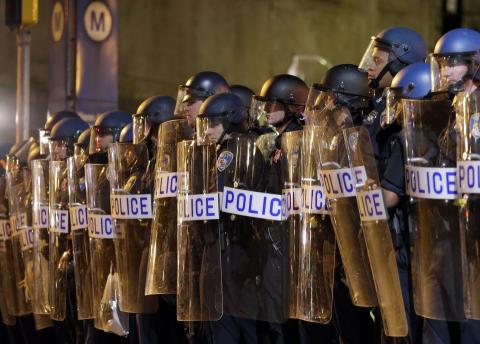2015: The Year in Race Relations
The Atlantic
December 29, 2015
by Tyler Bishop
From Ferguson to Charleston, longstanding problems erupted back into public view.
Every December, The Atlantic looks back on the previous year—to highlight not just the “big moments” but the progression of “big ideas.” Below, the second of three installments looks at the year in race-relations coverage.
U.S. race relations were on a downward slide as 2015 began. The previous November, a Ferguson, Missouri, grand jury declined to indict Darren Wilson in the fatal shooting of Michael Brown. The case propelled the issue of police violence—and racism—into the national spotlight. But it was just one of many.
In March, Ta-Nehisi Coates wrote about a due-process double standard in “The Gangsters of Ferguson.” It was a big year for Coates, too: He was named a MacArthur Fellow for his writing on race, and he took home the National Book Award for Between the World and Me, an exploration of the heritage of black exploitation that The Atlantic excerpted as “Letter to my Son.” Ferguson’s institutional problems run deep, and Walter Johnson highlighted one of them—the reliance on fines and fees from its poorest residents—in, “Ferguson’s Fortune 500 Company.”
In April, Freddie Gray died in Baltimore police custody, and the nation erupted once again. Conor Friedersdorf dug into “The Brutality of Police Culture in Baltimore.” A string of questionable police killings led Jason Lee Steorts to ask, “When Should Cops Be Able to Use Deadly Force?” In June, Matt Ford reported that “America’s Largest Mental Hospital Is a Jail” and highlighted one prison’s attempt to treat the mentally ill better. In September, Jeffrey Goldberg explored Louisiana’s efforts to end a black murder epidemic: “A Matter of Black Lives.”
There was momentum for criminal-justice reform on both sides of the aisle this year. Molly Ball delved into one seemingly suspicious source of enthusiasm in “Do the Koch Brothers Really Care About Criminal-Justice Reform?” And in “The Black Family in the Age of Mass Incarceration,” Ta-Nehisi Coates examined America’s failure to reckon with a history of failed reforms.
The 150th anniversary of the Civil War’s end arrived in 2015. In April, David Blight explained why Americans have yet to make peace with questions at the heart of that conflict in “The Civil War Isn’t Over.” That point was driven home in June, when Dylann Roof walked into a Charleston, South Carolina, church and took the lives of nine black people. Following the shooting, James Fallows spotlighted the president’s seminal speech: “Obama’s Grace.” Ta-Nehisi Coates demanded, “Take Down the Confederate Flag—Now.” Yoni Appelbaum traced the flag’s history, from the Civil War through the civil-rights era: “Why Is the Flag Still There?” An excerpt from Stuart Stevens’s The Last Season contextualized Southern culture’s muddled affection for the Confederacy. And I reflected on the symbol, as a young black Southerner, in “Reclaiming Southern Pride.” Just weeks after the murders, the state legislature and governor lowered the flag.
Ferguson propelled the issue of police violence—and racism—into the national spotlight. But it was just one of many cases.
Racial tension also reached a tipping point on college campuses. “The Coddling of the American Mind,” ignited discussion about colleges shielding students from reality. Conor Friedersdorf wrote about how “microaggressions” on campus resulted in “The Rise of Victimhood Culture.” He also examined the relationship between increased racial sensitivity and censorship in “The New Intolerance of Student Activism.” Gillian White’s counterpoint, “The Vilification of Student Activists at Yale,” explained how emphasizing the protesters’ actions obscured the injustices they tried to reveal. “The Crumbling Monuments of the Age of Marble,” by Mason Williams, explored the tension between beloved monuments and the often-controversial figures they memorialize. And Andrew McGill exposed that the share of African American students at top schools has been stagnant for decades despite an overall uptick in minority college enrollment: “The Missing Black Students at Elite American Universities.”
The year’s events exposed the pervasive nature of racial tension in the United States—from the brutality against and mass incarceration of black Americans all the way down to, as Doug Glanville wrote, being “Shunned by Taxi Drivers.”
Republished from The Atlantic.
Photo Credit: Patrick Semansky / AP





